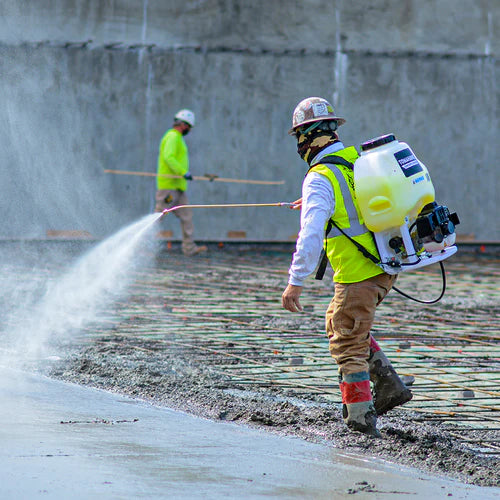The Tomahawk TCS6.5 Concrete Sprayer is the perfect tool for applying water-based concrete retardants, forming oils, and more.
This Concrete Sprayer is a 2 stroke engine that runs on a minimum of 50:1 fuel mix. It uses 91 octane gas and two cycle engine oil.
Note: 50:1 pre-mix fuel is ideal for this product as it contains fuel stabilizer to ensure longevity of the equipment. Premix fuel can be found at your local hardware store or auto shop.
If you are experiencing issues with your Concrete Sprayer, follow this guide to get it up and running again:
Concrete Sprayer Fails To Start
- Fuel-injecting pump: Push continuously until fuel is seen.
- Water has been mixed with fuel: Replace the fuel.
- Spark Plug has deteriorated: Replace if needed.
- Spark Plug: Check if there is bad contact between the spark plug and lead wire.
Concrete Sprayer Engine Is Bogging Down
- Choke is not fully open: Open to full position.
- Fuel Ratio: Ensure fuel ratio is correct. Replace if needed.
- Water has been mixed with fuel: Replace the fuel.
- Air Filter: Clean if dirty.
- Muffler Outlet and Cylinder: Clean if dirty.
- Piston, Piston Ring, and Cylinder: Replace if worn.
Concrete Sprayer Stops While Running
- Fuel: Add more if needed.
- Lead Wire: Check if it is loose, replace if needed.
- Plug is covered with carbon: Replace.
- Clogged Filter: Clean out.
- Water has been mixed with fuel: Replace the fuel.
- Air hole in the tank is clogged: Clean out.
Liquid Is Not Spraying
- Clogged Inlet and Outlet Valve: Clean or replace.
- Damaged Washer: Replace
- Damaged Bearing: Replace
- Damaged Piston: Replace
Low or No Spraying Pressure
- Worn Steel Ball: Replace
- Worn Valve: Replace
- Regulating Spring: Replace
- Damaged Piston: Replace
- Clogged Inlet and Outlet Valve: Clean or replace.
- Holes of Spraying Sheet Worn Down: Replace
- Clogged Spraying Accessories: Clean
Concrete Sprayer Cleaning
Immediately after each use of your Tomahawk Concrete Sprayer it is important to clean it properly:
- Fill the solution tank of the sprayer with 2-3 gallons of water.
- Start the engine and proceed to spray the water into a waste receptacle.
Routine cleaning will help to clean out the sprayer’s pump, hoses, and spraying attachments – while reducing the chances of the system clogging.
DO NOT use Xylene or any explosive chemical in the cleaning process. This concrete sprayer is meant for use with water-based or waterborne compounds only. Do not spray solvent-based or explosive liquids with this sprayer. Failure to comply may cause serious bodily harm or death.
Concrete Sprayer Storage
For long-term storage of the sprayer, first perform all regular maintenance procedures and needed repairs. Follow these steps to properly store your concrete sprayer:
- Empty the fuel tank.
- Disconnect the fuel supply line from the carburetor and depress the primer bulb until fuel stops discharging from the fuel-return line.
- Start the engine and allow it to run until it stops.
- Pull the starter cord a few times to remove any excess fuel from the engine.
- Remove the spark plug and insert a small amount of oil into the cylinder.
- Slowly pull the starter cord and bring the piston to a position closest to the spark plug hole.
- Re-install the spark plug.
- Apply a thin coating of oil to all the metal surfaces and store the duster in a dry place.
Compatible Nozzles
Concrete Sprayer Applications
- Concrete Curing
- Concrete Retardant
- Concrete Forming
Additional Concrete Sprayer Guides
How To Replace A Carburetor On A Backpack Sprayer










